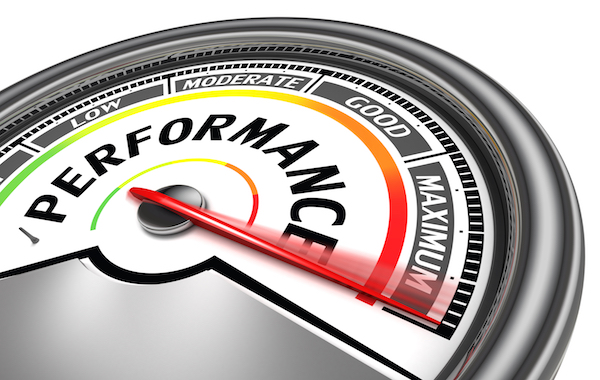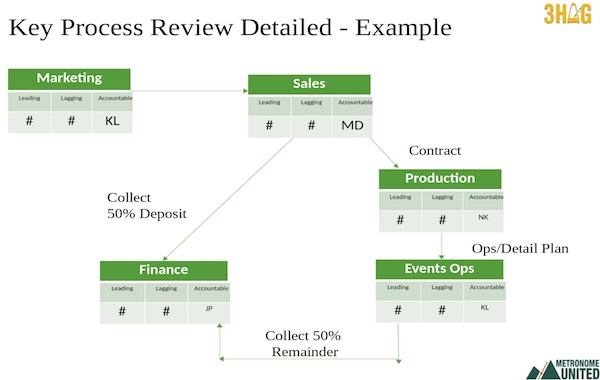Simple question. Does your business have the right people, doing the right things in the right way? It’s common for businesses that are growing rapidly to have a lack of clarity around who’s doing what. Important facets of the company get forgotten, with little or no ownership resulting in inefficiency and poor performance.
Sometimes I visit organisations that don’t even have an org chart. They tell me, ‘We’re growing so fast it isn’t worth doing’ or ‘The CEO’s allergic to them’. I can sympathise with this. The problem with org charts is they only show reporting lines and not who’s accountable for important, customer-impacting, cross-functional processes.
It’s worth me spelling out the difference between responsibility and accountability here. With accountability, the buck stops with you. You own the issue, task or role entirely. If it goes wrong, you admit that the fault lies with you. Conversely, responsibility can be shared. You can work with a team of people to divide responsibility equally. Responsibilities are often given out by the accountable person.
So, it’s vital that you nail down accountabilities as early as you can in your business. Instead of focusing on out-of-date org charts that give no clear definition, you need a new set of tools to navigate your way through. This is where the Fourth Rockefeller Habit kicks in. So, what does it suggest?
Work out who’s accountable for every business area, functional and cross-functional
As part of my two-day kick-off with new clients, we work through the Function Accountability Chart which is a Scaling Up Growth tool. All areas of the business are listed – Marketing, Sales, HR, IT, Learning and Development, Finance, Head of Company, Customer Satisfaction – and a set of terms agreed. The aim is to ensure one name has overall accountability for each area. Some names will appear in more than one box. This stimulates productive conversation around the things that are important to customers and staff and who’s accountable for these things. We work through the things that cause most friction in the business and make sure they’re allocated.
Some areas are standard to all businesses but there’s also the opportunity to add in specific characteristics or roles e.g. Chief Information Security Officer or Customer Advocacy. I always ask for a Chief Metronome Officer because I provide Metronome Growth Software (MGS) to all my clients. Someone needs to own the rolling out and use of this software in the business.
It’s fascinating to me. Some leadership teams rattle through this exercise in super-quick time. It’s obvious to them who’s accountable for the various functions. No ambiguity. In others, it’s a lot murkier. I always remember one of the first companies I coached, before I began using the Function Accountability Chart. It was two years before we realised that the CEO was merely a job title. In fact, the three Founders were jointly performing this role as co-CEOs. Now, I always start by getting this clarity first!
Not only do we work through the Function Accountability Chart for the company today, but we also produce a future chart as a destination once the 3HAG (3 Year Highly Achievable Goal) has been achieved. This is always interesting. Say the Head of Company is also currently the Head of Sales. In three years’ time, they probably won’t be. So, as a team, we decide at what point in terms of revenue would they relinquish that responsibility? Which quarter would that happen in? This is great because people who might see themselves in that role can see the timetable. If they want to put themselves forward, they can do that now and the team can help them succeed. Or a recruitment plan goes into action – a nice bit of succession planning!
Decide how to measure accountability

So, you’ve decided who’s accountable for what. Now, you need some criteria to keep progress on track and measure success. On the right of the Functional Accountability Chart, there are two columns for leading and lagging indicators. As a team, you need to decide what these are for each of the functional and cross-functional roles and areas.
Most companies will have lagging indicators – for a Head of Sales, it might be revenue or sales order intake. But they’re less clear about their leading indicator. You need to be thinking, in the next quarter, what number do you track so that you know that the lagging indicator will be on target next quarter? Take my Head of Sales example. You might know that it takes 400 customer demos per quarter to hit your sales target. So, if your lagging indicator is sales order intake, your leading indicator might be the number of demos sat in the quarter. On the dashboard of your MGS, you would closely monitor this number to check you were on course.
Another example – HR. Your lagging indicator might be headcount or open vacancies. You might know that you need to see an average of 100 CVs to fill a role so your leading indicator is CVs received, keeping a close eye on your pipeline to ensure your recruitment objective is met. It’s up to your team to decide the numbers that mean something to your organisation. Make sure that you’re measuring the right things.
Go through your P&L and assign accountability
Your exec team are smart. You want everyone in your company to know, if you give them a problem, they’ll fix it. They need to be on the front foot. There’s nothing worse than getting to the end of the year and spotting something that looks strange in the finances and launching a retrospective investigation. Far better to decide you’re going to track things in real-time and ensure accountability if any problems or discrepancies crop up.
It’s really not complicated. The fourth Rockefeller Habit suggests that you go through the P&L and balance sheet, line by line, and assign accountability for each of the items. People think financial statements are owned by the CFO. Yes, they might own the reporting but they certainly don’t own the line items. Once you’ve allocated everything, Finance will know who to go to when they see anomalies on reports to seek clarification. They don’t need a separate meeting of the whole team.
Take ‘Travel’ as an example. Decide who in your Executive Team is going to own the budget, policy and conversations around travel. Maybe it would be sensible to choose someone whose team travels a lot. Every day, week, month and quarter, he or she gets an insight into what’s happening, actual against budget. Rather than abdicating to HR, travel is controlled by the person who spends the most as a department. I’ve worked in organisations where this didn’t happen and the budget spiked out of control. Nobody knew until too late as there was no ownership.
Bring accountability to processes

At this point in my coaching sessions, I move towards Shannon Susko’s 3HAG methodology and deviate slightly from the Rockefeller Habits. Shannon devised a fab tool called the ‘Key Process Flow Map’ (see above). This provides a detailed picture of the customer’s journey through your company alongside the lagging and leading indicators you’ve already identified. It clearly shows who’s accountable at each stage and allows you to rate each of the elements red, amber and green, showing where you’re at with each of the processes (Marketing/Sales/Delivery/Billing).
Take Marketing as an example. A customer will come to the company because of marketing activity, get sold to, sign a contract, pay a deposit, have a product or service delivered and then receive and pay an invoice. Following which, account management might try and sell them something else. Who’s accountable for Marketing? You know that from your Functional Accountability Chart. What are the leading and lagging indicators? That’s Level 1. Further on in my coaching relationship with a client, we may take the map to Level 2 or 3, examining the indicators and forming OKRs (Objectives and Key Results) from them. If the lagging indicator for Marketing is sales qualified leads, what does the accountable person need to do to make sure these get delivered and what are the numbers they need to shift?
We work through the colour stage for each of the processes. Red, amber or green. Which processes need focus? Where’s the bottleneck? I find it’s unusual for organisations to look at this as a flow map. They tend to see processes in isolation from one another. Once the executive team is asked to identify the weakest link, they’ll instantly know the answer. Then they can focus effort on fixing it.
Sometimes there are obvious gaps where there’s no exec accountable. You might have an Ops Director but delivery is run by a delivery manager. So that bit of the process needs some detailed intervention to make it green. Objectives and key results are set around fixing this and are added to the accountable person’s individual quarterly objectives.
This exercise often throws up a complete lack of data. I worked through a Key Process Flow Map with a client recently. Quite early on, it was clear they were reporting, but not on the right things. We were looking at their quote to cash cycle but they didn’t have any of the right data – no information on the number of leads they had, what their conversion rates were, how many deals they’d secured etc. The Sales Director had been allowed to get away with this for too long.
Because their business was run as a series of silos, the Executive team hadn’t understood that high performing teams need to be in each other’s shorts. Whilst they may have been unhappy about how Sales was being run, there was no mechanism to have that conversation. The Process Flow Map provided that mechanism. Now they could say, ‘OK Mr Sales Director. You’re accountable for this so you need to fill in the blanks. Everyone agrees we need this data.’ This enabled a complete shift in mindset.
Appoint an advisory board

As part of the 3HAG process, you identify the three to five capabilities that are going to differentiate your business as part of your ‘attribution map’. These are typically owned by the CEO who needs to decide whether their organisation has the right knowledge, skills and experience in-house to bring them to fruition. If not, then I always suggest setting up an Advisory Board.
It’s not the same as inviting people onto your board as non-exec directors. I think this is why so many clients are reluctant to get moving with this – they don’t realise that there’s a different way. Let’s say you need help with channel marketing or knowledge of a new foreign market. Decide the terms and remuneration on offer and network until you find someone with the knowledge, connections and perfect black book. There are many people out there, at the tail end of their careers, who want to give something back.
Remember, they don’t need regulatory of governing responsibility – I think it’s better to keep stewardship and governorship as separate things. And they don’t need to take out any insurance. Meetings can be quarterly or six-monthly – not too onerous but enough to help you steer the right course. One thing’s for sure – an advisory board is invaluable if you’re trying something new.
By now, I hope I’ve convinced you to spend time working on accountability in your business. It really is vital. Without it, you’ll find lack of ownership, clarity and productivity creep in like cancer, slowing down or halting the growth you want to achieve.
Written by business coach and leadership coaching expert Dominic Monkhouse. Contact him to schedule a call here. You can order your free copy of his book, Mind Your F**king Business here.

